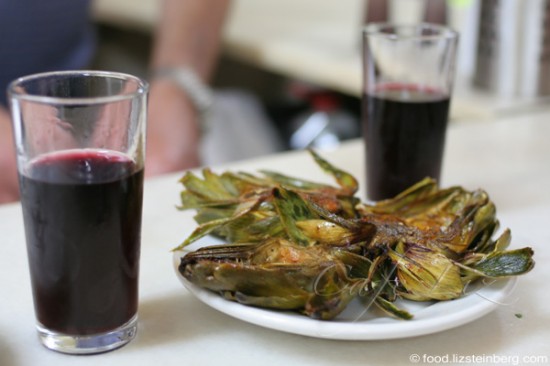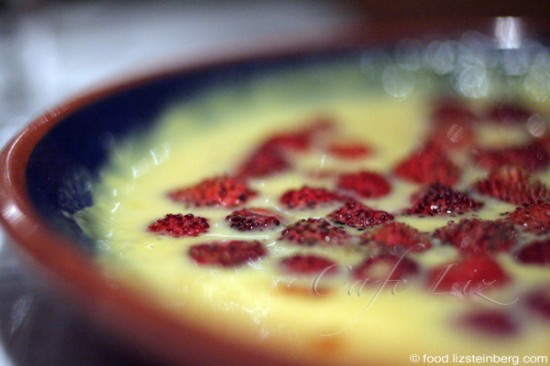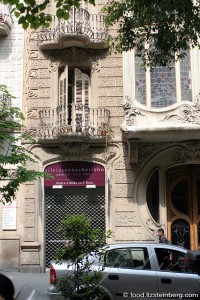Dining and dishing in Barcelona

Where have I been for these past two weeks? Two continents and more than a dozen towns on the other side of the Mediterranean basin — Spain and Morocco.
From a culinary standpoint, it’s interesting to note both the similarities and the differences between these countries’ cuisines and Israel’s. We all have markets teeming with fresh fruits and vegetables, including things such as loquats that are less common elsewhere in the world (and yes, Israel’s markets measure up to La Boqueria, below); we all sell olives by the bushel; we all give tomatoes, onions and garlic a prominent role; and we all have ready supplies of legumes such as chickpeas.


What we do with all these raw ingredients is what’s interesting. For instance, chickpeas are sold freshly cooked in Spanish delis — all of 2 minutes away from being blended into a wonderful hummus. Yet people don’t make hummus there. Why? And Morocco has a surplus of lemon and mint for the ubiquitous mint tea, yet we didn’t see a single limonana. Sultry Morocco and cool limonana seem like they should be a match made in heaven, but it seems no one has picked up this yet. Why? And why oh why doesn’t anyone make falafel? It’s the first thing I had when I got home.
And then there are the meats — the selection of meat and fish is much more limited in Israel, due to kashrut. In Spain, alongside the ubiquitous legs of ham you’ll also find plenty of skinned rabbits and curious shelled sea creatures, while in Morocco you’ll find not just rabbits but snails and camels.
However, both countries have some innovations when it comes to sandwiches. Spain has its bocadillos de tortilla espanola, a potato omelet smeared with some tomato and olive oil inside a roll. You wouldn’t think it, but it’s actually quite good. And Moroccans put not only cooked potatoes into sandwiches, but rice, too. That too isn’t half bad.
I’d been invited to Barcelona for a consultation on vegetable consumption in Europe organized by branding company Firma and hosted by PepsiCo and its Spanish subsidiary Alvalle, along with a handful of excellent food bloggers. No use spoiling a good thing, so I didn’t mention that technically Israel isn’t part of Europe; anyway, I suspected they already knew this. I used the opportunity to explore what Barcelona residents smilingly termed “deep Catalonia” before boarding a plane and following the immigrants home to Morocco (more on that in future posts), and to visit my good friend Arturo.

Our first day in town, Marc from Firma recommended that we check out a place across the street for a bit of local flavor — a typical Spanish tapas joint that appealed to a local workday crowd (c/Baluard 56B) next to the market in the charming Barceloneta neighborhood, away from the tourist crush. The door was unmarked, and the display counter was tempting — a colorful arrangement of typical Spanish dishes. Wine was on tap from three huge barrels behind the counter.
What do you have that’s vegetarian? we asked the proprietor.
Nothing, he said apologetically.
Fortunately, that wasn’t entirely true. We ordered ourselves some fried artichokes, garlicky marinated mushrooms and the ubiquitous Catalan pa amb tomaquet — bread smeared with tomatoes, olive oil and garlic — along with two little glasses of wine. We ate standing at the counter, soaking up the action as the little restaurant filled up for lunch hour.

Indeed, while Spain may not lack vegetables, they often come seasoned with meat or fish — the popular Catalan dish of escalivada, a mix of roasted eggplant, peppers and tomatoes, occasionally came topped with a rogue anchovy or two much to Eitan’s dismay. Breaded, bechamel-filled croquetas and bombas are often flavored with pork or chicken. Apparently vegetarians are uncommon there, and awareness of the issue is lacking.
This makes the restaurant that Firma’s Anna chose for lunch all the more special. Restaurant en Ville, (c/Doctor Dou 14, ☎ (34) 93 302 84 67), a charming place tucked away on a side street off the tourist-packed Rambla, offers three-course meals for 10-12 euros and marks its menu items as vegetarian and gluten-free. I had lovely cheese-filled ravioli and stewed fish, while Eitan had a curry couscous. My camera, for the record, happened to have half a clara during the course of that meal, but that’s another matter. This didn’t seem to faze it, fortunately.

Agua’s dessert of peppery cream and wild strawberries.
Dinner was at the more upscale Agua (Pg. Maritim de la Barceloneta 30, ☎ 93 225 12 72), a restaurant along the Barceloneta beach with well-done takes on Catalan classics, including potatoes with a spicy brava-esque tomato sauce, grilled asparagus with romesco sauce and classic seafood paellas and fidueas (only one was vegetarian). Our companions said you can judge the quality of a restaurant based on its crema catalana — a local version of creme brulee — and this one passed with flying colors. Tapas are somewhere between 5 and 10 euros, while mains range between 15 and 20 euros.


The view from the archives, left, and the old bullfighting ring, now a shopping mall, right.
But the city is not just about las Ramblas and the beach; packed with slow-moving tourists, las Ramblas is one of the locals’ least favorite places, Arturo told me. He wanders the Gothic quarter, feeling privileged to know the hidden corners that tourists often miss, such as the city archives behind the famed gothic Catedral (c/Santa Llucia 1) — entrance is free, and the second-floor patio offers a peaceful view of the street.

And next to city hall lies From Sant Jordi (c/Llibreteria 8, ☎ 93 310 40 16), an acclaimed bakery with traditional classics such as flaky coca pastry topped with sugar and pine nuts.


Near Diagonal, left, and Barceloneta, right.
But Arturo often prefers the quiet verdant neighborhoods around Diagonal, one of the city’s main streets. Tucked among the swirling art nouveau buildings are numerous little eateries of every shape and size, from traditional Spanish tapas bars to more modern establishments. O’Vall D’Ouro (c/Rossello 203, 93 237 30 31) offered a tempting range of tortillas espanolas beyond the traditional potato version, including one with asparagus and another with eggplant, while Arturo’s favorite art gallery-cum-cafe Cosmo (Avda. Laurea Miro 422, ☎ 93 666 25 51) offered fresh juices off a quiet pedestrian boulevard.

At this point, you can’t discuss Catalan cuisine without mentioning home-grown chef Ferran Adria, master of world-renowned restaurant El Bulli. Maybe you’ve heard of Adria, Arturo said to me. Maybe? No maybe about it. Barcelona has readily embraced Adria’s molecular cuisine, with a spattering of molecular restaurants as well as cooking courses promising to teach you to make fake caviars and foams (Arturo and I had planned to attend such a course, in Spanish, but it was postponed; we’d also discussed going to the Michelin-starred Cinc Sentits for the 30-euro lunch tasting menu.). Gadgets Cuina (c/Arago 249, Zamfra Rambla Catalunya, ☎ 93 487 48 58), a local cooking store had an entire section devoted to the equipment and ingredients Adria made famous. I took home some chemicals to make caviar — a fitting souvenir.
Meet the other bloggers
I had the pleasure of meeting Meneer from Holland (site in Dutch), Pepe from southern Spain (in Spanish), Julia from Tuscany, Niamh from London, Anne from France (in French) and Luisa from Berlin, an impressive group with at least four cookbooks in its collective name. We ate, we laughed, we photographed our food.

